Meu SciELO
Serviços Personalizados
Artigo
Indicadores
-
 Citado por SciELO
Citado por SciELO
Links relacionados
-
 Similares em
SciELO
Similares em
SciELO
Compartilhar
Podium. Revista de Ciencia y Tecnología en la Cultura Física
versão On-line ISSN 1996-2452
Rev Podium vol.16 no.1 Pinar del Río jan.-abr. 2021 Epub 15-Abr-2021
Original article
Relationship between psychological variables and sports injuries in baseball pitchers
1Centro Provincial de Medicina del Deporte de Villa Clara. Villa Clara, Cuba.
2Universidad Central "Marta Abreu" de Las Villas. Facultad de Cultura Física. Villa Clara, Cuba.
A cross-sectional, descriptive and correlational study was carried out to determine the relationship between psychological variables and injuries in 34 baseball pitchers of different competitive levels. Injuries were described by frequency analysis and percentage distribution, as well as mean, standard deviation, asymmetry and kurtosis for psychological variables; the K-S normality test was also performed for the sample. The psychological variables were compared between groups of pitchers by means of a one-factor Anova and the relationship between both groups of variables was analyzed by means of Pearson's correlation coefficient. Psychological variables were compared in relation to injuries, using the t-test for independent samples and one-factor Anova in each case, with a confidence interval of 95 % where p≤0.05. The questionnaire of sports aspects and injuries, trait-state anxiety inventory, state anxiety inventory in competition and psychological inventory of sports performance were used; a marked presence of injuries and a psychological profile where trait-anxiety, attention control, self-confidence, motivational level and positive coping control constitute the strong points were obtained, with differences in anxiety, according to the competitive level. Except for attitude control, psychological skills showed a relationship with injuries. The throwers with greater number and severity of injuries during the competitions present greater anxiety. It is concluded by affirming that the psychological preparation of the baseball pitcher should have the purpose of optimizing his sports performance and preserving his state of health.
Key words: Anxiety; Psychological variables; Baseball pitchers; Sports injuries.
INTRODUCTION
It is now an irrefutable fact that sports injuries are complex and multi-causal in nature, as well as their negative repercussions on the health and sporting performance of those who suffer from them. Although the relationship of physical and technical factors with injuries is a widespread area of research since the first studies until today, it has not happened in a similar way with psychological factors, because since the beginning of research in the 70s of the last century, divergent results have been shown that have not allowed the establishment of a unitary criterion, so much so that there is still a shallow knowledge of the subject in professional practices in the Cuban sports context.
Psychology approaches the study of sports injuries in different ways despite the fact that the "Stress and Injury Model" Andersen (1988) guides the research. Although it is recognized by the scientific community that certain psychological factors are related to injuries, this relationship can also occur in a specific way, since the same factor has shown different results in different populations, depending on the sport, the degree of specialization of athletes, training and competition systems, psychodiagnostic instruments, analytical procedures and many other factors that have not allowed the theoretical-methodological systematization of these relationships, which, moreover, have a marked dialectical character.
However, the rapid development of scientific research on the subject has led to the creation of very specific lines of research, supported by numerous relevant findings, which have allowed a group of experts of the International Olympic Committee to reach a general consensus on risk factors, in which the role of psychological processes in the configuration of vulnerability to injuries is recognized Soligard, et al., (2016), in addition to other publications by groups of experts in the study of sports injuries DiFiori, et al., (2014); Herring, Kibler, Putukian, (2017); Schinke, Stambulova, Moore, (2018).
The present study covers the first two lines of research constituted in the first decade of the present 21st century and defined by Olmedilla y García-Mas (2009), addressing the relationship between psychological factors and the athlete's vulnerability to injury Berengüí-Gil, Garcés de Los Fayos, Hidalgo-Montesinos, (2013); (Berengüí-Gil, Garcés de Los Fayos e Hidalgo-Montesinos, 2013; Berengüí-Gil y Puga, 2015; González-Reyes, Moo, Olmedilla, Prieto y Blas, 2017; Johnson e Ivarsson, 2011; Zurita Ortega, 2014) and injury history and its influence on athlete psychology, Abenza, Olmedilla and Ortega, (2010); Ramírez, Alzate and Lázaro, (2010) Ríos, Pérez, Fuentes and De Armas, (2019).
The present research attempts to overcome one of the shortcomings in this area of knowledge, identified by Olmedilla, Prieto and Blas, (2011) in that researchers have explored more than 30 different psychological variables in various researches, where the vast majority of authors studied a total of three factors, being less frequent researchs with four or more variables. For this, a group of multidimensional studies have been taken as references, which have shown a relationship between psychological abilities to compete and injuries, Berengüí et al., (2011); Berengüí et al., (2013); Berengüí and Puga, (2015); González-Reyes et al., (2017).
In the case of the study of sports injuries in baseball and, specifically, in pitchers, it is more frequent to find studies where physical, biomechanical and sports factors are related among other risk factors Riff et al., (2016); Bohne et al., (2015); Fleisigy Riff (2012); Kraan et al., (2019), however, there are researches that study the relationship of psychological variables with injuries in this sport, but in most cases they are part of heterogeneous samples where other sports are present, Klenk, (2006); Schlierf, (2017); Schneider, (2015), so the results cannot be systematized in terms of baseball pitchers.
Based on the above, the following objectives were designed:
To describe the injury status, anxiety and psychological skills associated with sport performance in pitchers.
To compare the psychological variables according to the competitive level of the throwers.
To relate the status of psychological variables with injuries.
To compare the psychological variables among pitchers, according to the variables related to the injury.
MATERIALS AND METHODS
The research responds to a descriptive, cross-sectional and correlational design. The measurements were taken in the middle of the national competitions of each of the three teams. It was worked with a population of 34 baseball pitchers, including all the members of the under 18 (10), under 23 (14) and 1st category (14) teams of Villa Clara province, who presented a chronological age between 16 and 33 years (M= 22.44; SD= 5.05) and a sport experience between 6 and 21 years (M= 12.12; SD=4.01).
Techniques and instruments
Questionnaire on sports aspects and injuries it was applied to identify the behavior of injuries in the population under study. It was developed by Olmedilla, García and Martínez (2006). It collects information related to the history of injuries, the number of injuries suffered, their severity and the context in which they occurred.
Trait-State Anxiety Inventory (IDARE) is the Spanish version of the State-Trait Anxiety Inventory (STAI) by Spielberger (1983) , Spielberger (1994), which is a test for the research of two different dimensions of anxiety: anxiety as a trait and anxiety as a state, in adult subjects without psychopathological symptoms. In this case, only the subscale Trait Anxiety was used.
Competitive Sport Anxiety Inventory Csai-2 Martens et al., (1990), in its Spanish version (Márquez, 1992). It consists of 27 Lickert-type response items. The items are distributed in three subscales that measure cognitive anxiety, somatic anxiety and self-confidence. For this research, we worked with the total score of anxiety achieved by each athlete.
For the evaluation of the psychological variables related to sports performance, the Psychological Inventory of Sports Performance (IPED) was used. This instrument is based on the work of adaptation and scoring of Hernandez (2007). It is an adaptation of the Psychological Performance Inventory (PPI) by Loehr (1986) and consists of 42 items, grouped into seven Likert-type response scales.) The scales are: self-confidence, negative coping control, attention control, visual and imaginative control, motivational level, positive coping control and attitudinal control.
Descriptive and inferential statistics were used, applying tests such as mean, standard deviation, skewness and kurtosis, taking into account, in addition, the frequencies of occurrence of the variables related to the injury by %. The normality of the data was checked using the Kolmogorov-Smirnov test, specifically for the psychological variables. Pearson's correlational test was applied to identify the relationship between injury-related variables and psychological variables. A one-factor Anova test was applied to compare the psychological variables among pitchers at different competitive levels and according to the number of injuries suffered. T-test for two independent samples was performed to compare the state of the psychological variables between pitchers who have been injured and those who have not been injured. In addition, it was used with the same objective, depending on the severity and the context where the injuries occurred. In any case, a statistical significance level of 95 % (p≤.05) was considered. For this statistical analysis, the SPSS for Windows software package was used (version 22.0, SPSS Inc.).
RESULTS AND DISCUSSION
Table 1 describes the behavior of sports injuries in the pitchers under study, showing that most of them have been injured on at least one occasion and that competition is the context of greatest incidence. In most cases, the injuries have been of moderate severity, so that the impact on sports performance and physical health has been discrete (Table 1).
Table 1 - Behavior of sports injuries in pitchers

LES= Injured athletes; NLES= Number of injured athletes; ENTR= Trainings; COMP= Competitions
Table 2 shows that trait anxiety, attitude control, self-confidence, motivational level and positive coping control constitute the strong points in the psychological profile of these athletes in general, while state anxiety in competition, negative coping control, attention control and visual-imaginative control are the weak points. It is evident that the data have a normal distribution (Table 2).
Table 2 - Descriptive statistics and normality analysis of psychological variables
| Mean | DT | Asimetría | Curtosis | KS | |
|---|---|---|---|---|---|
| Trait Anxiety | 44.35 | 4.98 | .59 | .63 | 1.07 |
| State Competitive Anxiety | 53.00 | 10.09 | .49 | -.69 | .81 |
| Self-Confidence | 26.82 | 3.36 | -.75 | -.63 | 1.22 |
| Motivational Level | 26.41 | 3.66 | -.78 | -.58 | 1.11 |
| Attention Control | 24.21 | 2.97 | -.33 | 21 | .90 |
| Negative Coping Control | 23.91 | 5.51 | -.56 | -.66 | .86 |
| Positive Coping Control | 26.29 | 3.08 | -.75 | .18 | 1.15 |
| Visual and Imaginative Control | 25,94 | 4,23 | -,91 | 1,77 | .56 |
| Attitude Control | 27,82 | 3.06 | -.55 | -.90 | 1.01 |
KS = Kolmogorov-Smirnov
Table 3 shows that only anxiety in competition establishes statistically significant differences among pitchers, according to the competitive level, being notably higher in those with less experience and sport mastery. The 1st category pitchers experience less anxiety during competitions (Table 3).
Table 3 - Comparison of psychological variables according to competitive level
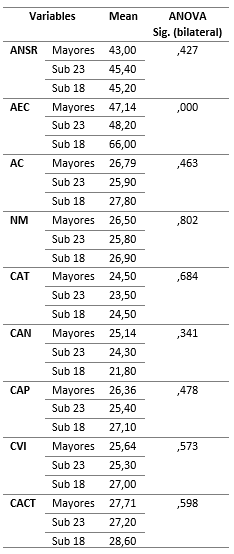
ANSR= Trait Anxiety; AEC= Anxiety State Competition; AC= Self-Confidence; NM= Motivational Level; CAT=Control of Attention; CAN=Control of Negative Coping; CAP= Control of Positive Coping; CVI=Control of Visual-Imaginative; CACT=Control of Attitude.
Table 4 shows that trait and state anxiety are not related to having been injured. However, trait anxiety establishes a positive relationship with the number of injuries and state anxiety with the severity and occurrence in competitions. With respect to psychological skills, their inverse relationship with the occurrence of injury can be appreciated, except for attitude control. Attention control also establishes an inverse relationship with injury severity. These data allow inferring that pitchers with less psychological skills are more prone to injury and that greater anxiety is associated with more severe injuries, which facilitates their occurrence in competitive situations (Table 4).
Table 4 - Relationship between psychological variables and injuries
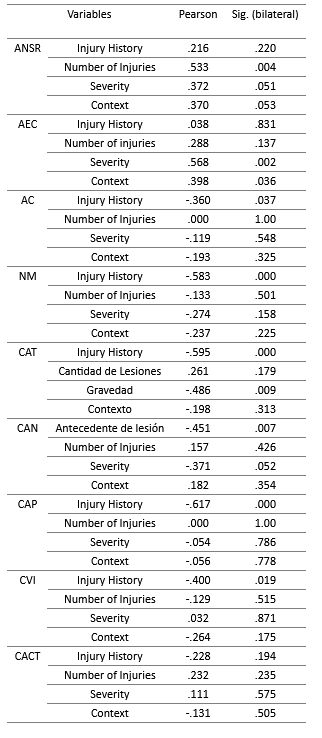
ANSR= Trait Anxiety; AEC= Anxiety State Competition; AC= Self-Confidence; NM= Motivational Level; CAT= Control of Attention; CAN= Control of Negative Coping; CAP= Control of Positive Coping; CVI= Visual-Imaginative Control; CACT= Control of Attitude.
Table 5 shows the statistically significant differences in psychological skills between pitchers who have not been injured and those with a history of injury, being congruent with the results previously presented. Pitchers who have been injured have lower self-confidence, motivational level, attention control, negative coping control, positive coping control and visual-imaginative coping control, but do not differ in terms of trait anxiety and state in competition (Table 5).
Table 5 - Comparison of psychological variables between injured and non-injured patients
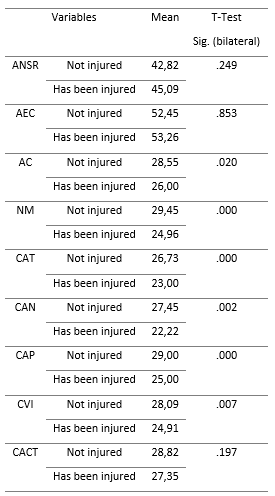
ANSR= Trait Anxiety; AEC= Anxiety State Competition; AC= Self-Confidence; NM= Motivational Level; CAT= Control of Attention; CAN= Control of Negative Coping; CAP= Control of Positive Coping; CVI= Visual-Imaginative Control; CACT= Control of Attitude.
Table 6 shows that state anxiety in competition is higher in throwers who have presented more severe injuries, as well as attention control and negative coping control are significantly lower in athletes who have suffered moderate injuries, although this last psychological skill did not show significant relationships with the severity of the injuries (Table 6).
Table 6 - Comparison of psychological variables in relation to injury severity
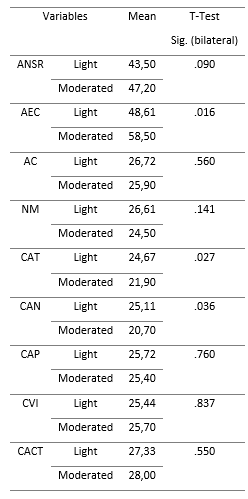
ANSR= Trait Anxiety; AEC= Anxiety State Competition; AC= Self-Confidence; NM= Motivational Level; AT= Control of Attention; CAN= Control of Negative Coping; CAP= Control of Positive Coping; CVI= Visual-Imaginative Control; CACT= Control of Attitude.
Table 7 shows that the athletes studied, who have presented more injuries during their career, have higher trait anxiety and that state anxiety in competition is higher as more injuries accumulate (Table 7).
Table 7 - Comparison of psychological variables in relation to the number of injuries
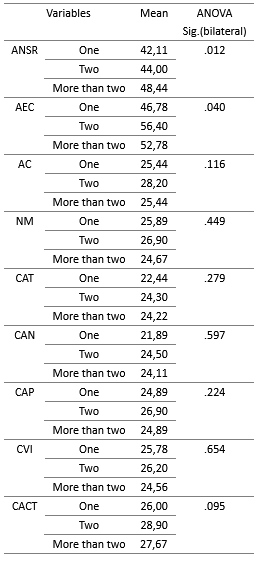
ANSR= Trait Anxiety; AEC= Anxiety State Competition; AC= Self-Confidence; NM= Motivational Level; CAT= Control of Attention; CAN= Control of Negative Coping; CAP= Control of Positive Coping; CVI= Visual-Imaginative Control; CACT= Control of Attitude.
Table 8 shows that both trait and state anxiety are higher in pitchers who have been injured during competitions, giving notable importance to the role of this emotion in the differentiation of the context in which the injury occurred, since in competitions, psychic tensions acquire a greater magnitude due to the multiplicity of potentially stressful factors that intervene in the athlete's performance (Table 8).
Table 8 - Comparison of psychological variables in relation to the context of injury occurrence
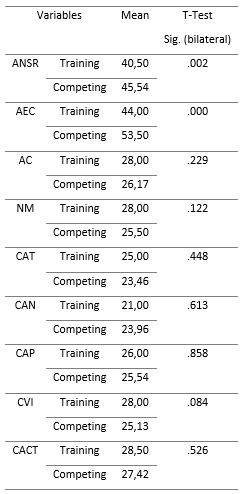
ANSR= Trait Anxiety; AEC= Anxiety State Competition; AC= Self-Confidence; NM= Motivational Level; CAT= Control of Attention; CAN= Control of Negative Coping; CAP= Control of Positive Coping; CVI= Visual-Imaginative Control; CACT= Control of Attitude.
The results on the high presence of injuries and the state of psychological variables are similar to those obtained by Ríos, Pérez, Fuentes and De Armas (2019). In addition, it was found that only the anxiety-state in competition establishes significant differences between the throwers according to the sport categories under study, showing that lower level athletes have this variable in lower average proportions.
Regarding the relationship between psychological variables and injuries, similar results were obtained to those presented by several researchers Berengüi et al., (2011); Johnson and Ivarson, (2011); Zafra, A. O., & García-Mas, A. (2009); Rivas et al., (2012); Zurita-Ortega et al., (2017) in terms of anxiety-trait, although with the particularity that in the present study it is not related to the fact of having been injured, but with the number of injuries suffered, since it presents a higher level of anxiety as a stable personality characteristic, it has an impact on a greater probability of re-injury, in these athletes.
The anxiety-state in competition establishes relationships with the severity of the injury and the context where they occur. If it is taken into account that the context of greatest occurrence is the competitive context, in which the stressors of sporting activity acquire their maximum expression, this relationship can be justified on the basis of the theoretical assumptions of Andersen and Williams (1988). These results are similar to those obtained in several preceding researches in different sports and contexts (Olmedilla et al., 2006; Rivas et al., 2012; Prieto et al., 2015), however, they differ from other studies such as those conducted by Ramírez et al., (2010); Berengûi and Puga, (2015) and González-Reyes et al., (2017).
Another group of variables, made up of self-confidence, motivational level, negative coping control, positive coping control, visual-imaginative control and attention control, are significantly and inversely related to the fact of having been injured, indicating that the lower the degree of these variables, the greater the number of pitchers who have suffered injuries. In addition, it should be noted that the lower the level of attentional control, the greater the severity of the injuries.
With respect to self-confidence, its relationship with injuries is contrary to the results obtained in soccer players by Olmedilla (2006), since in his research, athletes with high self-confidence tend to get injured more, but they correspond with the studies by Abenza et al., (2009) and Berengüí et al., (2011).
The results obtained in the motivational level variable differ from those obtained by Olmedilla et al., (2006); Berengüí et al., (2011); Berengüí and Puga (2015); González-Reyes et al., (2017), which found no relationship between motivation and injuries, but correspond to the study by Olmedilla et al., (2009), since this author found that motivation is positively related to a lower incidence of moderate grade injuries, when this is established at medium levels.
Las relaciones inversas entre el control de afrontamiento negativo y las lesiones coinciden con varios estudios, Berengüí et al., (2013); Berengüí y Puga, (2015); González-Reyes et al., (2017). Esta misma relación negativa, hallada entre el control de afrontamiento positivo con las lesiones, no coincide con los resultados de un estudio realizado por Berengüí et al., (2013), pero son similares a los obtenidos en otras investigaciones Berengüí et al., (2011); Berengüí et al., (2015); González-Reyes et al., (2017).
The relationship shown by the visual-imaginative control with injuries, in the present study, does not coincide with the results of research in other sports, Berengüí et al., (2011); Berengüí et al., (2013); Berengüí et al., (2015), González-Reyes et al., (2017), while the inverse relationship found between Attention Control and injury is similar to that obtained by several authors, as more throwers appear with a history of injury when control over this important cognitive process is low during competition, Olmedilla et al., (2009); Berengüí and Puga, (2015).
Despite the above, the results described above differ from these same studies in the sense that the athletes, who controlled their attentional processes better, showed a tendency to be injured in fewer opportunities, while in this case the throwers did not show this tendency, but rather, the less control, the greater the severity of the injuries suffered. In addition, other studies such as those conducted by González-Reyes et al., (2017) and Berengüí et al., (2011) show no relationship between these variables.
The results of the attitude control variable, which showed no relationship with injuries, correspond with the studies by Berengüí et al., (2011) and Berengüí et al., (2013), disagreeing in turn with those shown by Berengüí et al., (2015) and González-Reyes et al., (2017).
With respect to the comparison of the psychological variables among the pitchers, it was obtained that those, who have been injured, have lower self-confidence, motivational level, attention control, negative coping control, positive coping control and visual-imaginative control. In addition, no statistically significant differences are established for anxiety and attitude control. These results coincide with those obtained by Ríos et al., (2019) in a study with 1st category pitchers in a partial way, since in that study no significant differences were established in the motivational level nor in positive coping control, but in State Anxiety in competition. They also correspond with Liberal et al., (2014), since this author also found no significant differences in anxiety.
In relation to the severity of the injuries, it was obtained that anxiety-state in competition, attention control and negative coping control establish statistically significant differences in the throwers, in such a way that those who have suffered moderate injuries present greater anxiety during competitions and less control of negative emotions and over attention. The specific results of anxiety coincide with the findings of Abenza et al., (2010), although they differ in self-confidence, since in that same study it was determined that athletes who experienced severe and very severe injuries had lower self-confidence.
Regarding the number of injuries, it was obtained that anxiety-trait and state in competition is significantly higher in pitchers who have suffered more injuries. These results do not correspond with those obtained by Ríos et al., (2019) in a similar population, since it was only identified in that preceding study that self-confidence and negative coping control were lower in pitchers who had been injured more times. Anxiety, moreover, shows significant differences in the current study, depending on the context where injuries occur, as they reach higher levels in pitchers who have been injured in competitions.
These results allow concluding, inferring that the psychological abilities to compete are correlated in greater proportion with the occurrence or absence of injuries, which acquire, even, lower values in pitchers with a history of injury. While the differences found in trait anxiety and state in competition show the negative repercussions in pitchers who have suffered more injuries during competitions, which allows concluding that the psychological preparation of the baseball pitcher must fulfill a double function: to optimize his sports performance and also to preserve his state of health.
Based on the above, it is recommended to continue conducting similar studies with pitchers from other regions of the country to systematize the results in such a way that they contribute to generate intervention programs to reduce psychological vulnerability to injuries and provide adequate coping of athletes, minimizing their negative effects, as well as to develop longitudinal research to determine the role of psychological variables in the etiopathogenesis of sports injuries in baseball pitchers.
REFERENCIAS BIBLIOGRÁFICAS
Abenza, L., Olmedilla, A., Ortega, E., & Esparza, F. (2009). Lesiones y factores psicológicos en futbolistas juveniles. Archivos de Medicina del Deporte, 36(132), 280-288. http://archivosdemedicinadeldeporte.com/articulos/upload/Original_Factores_280_132.pdf. [ Links ]
Abenza, L., Zafra, A., & Ortega, E. (2010). Efectos de las lesiones sobre las variables psicológicas en futbolistas juveniles. Revista Latinoamericana de Psicología, 42. https://www.researchgate.net/publication/49613691_Efectos_de_las_lesiones_sobre_las_variables_psicologicas_en_futbolistas_juveniles [ Links ]
Andersen, M. B., & Williams, J. M. (1988). A Model of Stress and Athletic Injury: Prediction and Prevention. Journal of Sport and Exercise Psychology, 10(3), 294-306. https://doi.org/10.1123/jsep.10.3.294 [ Links ]
Berengüí, R., M. López Gullón, J., J. Garcés de los Fayos Ruiz, E., & Almarcha Teruel, J. (2011). Factores Psicológicos y Lesiones Deportivas en lucha Olímpica y Taekwondo. Revista de Ciencias del Deporte, 7, 91-98. https://www.researchgate.net/publication/50434530_Psychological_factors_and_sports_injuries_in_olympic_wrestling_and_taekwondo_FACTORES_PSICOLOGICOS_Y_LESIONES_DEPORTIVAS_EN_LUCHA_OLIMPICA_Y_TAEKWONDO [ Links ]
Berengüí-Gil, R., Garcés de Los Fayos, E. J., & Hidalgo-Montesinos, M. D. (2013). Características psicológicas asociadas a la incidencia de lesiones en deportistas de modalidades individuales. Anales de Psicología, 29(3), 674-684. https://doi.org/10.6018/analesps.29.3.175811 [ Links ]
Berengüí-Gil, R., & Puga, J. L. (2015). Predictores psicológicos de lesión en jóvenes deportistas/Psychological Predictors of Injury in Young Athletes. Revista Costarricense de Psicología, 34(2), 113-129. http://www.rcps-cr.org/openjournal/index.php/RCPs/article/view/67 [ Links ]
Bohne, C., George, S. Z., & Jr., G. Z. (2015). Knowledge of injury prevention and Prevalence of risk factors for throwing Injuries in a sample of youth baseball players. International Journal of Sports Physical Therapy, 10(4), 464-475. https://www.ncbi.nlm.nih.gov/pmc/articles/PMC4526793/ [ Links ]
DiFiori, J. P., Benjamín, H. J., Brenner, J. S., Gregory, A., Jayanthi, N., Landry, G. L., & Luke, A. (2014). Overuse injuries and burnout in youth sports: a position statement from the American Medical Society for Sports Medicine. British Journal of Sports Medicine, 48(4), 287-288. https://doi.org/10.1136/bjsports-2013-093299 [ Links ]
Fleisig, G. S., & Andrews, J. R. (2012). Prevention of Elbow Injuries in Youth Baseball Pitchers. Sports Health, 4(5), 419-424. https://doi.org/10.1177/1941738112454828 [ Links ]
González-Reyes, A. A., Moo Estrella, J., & Olmedilla Zafra, A. (2017). Características psicológicas que influyen en las lesiones deportivas de triatletas amateurs de Yucatán, México. Revista de psicología del deporte, 26, 0071-77. https://ddd.uab.cat/record/181270 [ Links ]
Hernández, A. (2007). Un cuestionario para la evaluación psicológica de la ejecución deportiva: Estudio complementario entre TCT y TRI. Revista de psicología del deporte , 15(1), 71-93. https://revistes.uab.cat/rpd/article/view/239 [ Links ]
Herring, S. A., Kibler, W. B., & Putukian, M. (2017). Psychological Issues Related to Illness and Injury in Athletes and the Team Physician: A Consensus Statement. Medicine and Science in Sports and Exercise, 49(5), 1043-1054. https://doi.org/10.1249/MSS.0000000000001247 [ Links ]
Johnson, U., & Ivarsson, A. (2011). Psychological predictors of sport injuries among junior soccer players. Scandinavian Journal of Medicine & Science in Sports, 21(1), 129-136. https://doi.org/10.1111/j.1600-0838.2009.01057.x [ Links ]
Klenk, C. (2006). Psychological Response to Injury, Recovery, and Social Support: A Survey of Athletes at an NCAA Division. Senior Honors Projects. https://digitalcommons.uri.edu/srhonorsprog/9 [ Links ]
Kraan, R. B. J., Nobel, D. de, Eygendaal, D., Daams, J. G., Kuijer, P. P. F. M., & Maas, M. (2019). Incidence, prevalence, and risk factors for elbow and shoulder overuse injuries in youth athletes: A systematic review. Translational Sports Medicine, 2(4), 186-195. https://doi.org/10.1002/tsm2.82 [ Links ]
Liberal, R., Escudero, J. T., Cantallops, J., & Ponseti, J. (2014). Impacto psicológico de las lesiones deportivas en relación al bienestar psicológico y la ansiedad asociada a deportes de competición. Revista de psicología del deporte , 23(2), 451-456. https://dialnet.unirioja.es/servlet/articulo?codigo=4872395 [ Links ]
Loehr, J. E. (1986). Mental Toughness Training for Sports: Achieving Athletic Excellence. Stephen Greene Press. https://www.amazon.com/Mental-Toughness-Training-Sports-Excellence/dp/0828905746 [ Links ]
Martens, R., Burton, D., Vealey, R. S., Bump, L. A., & Smith, D. E. (1990). The Competitive State Anxiety Inventory-2 (CSAI-2). En: Competitive anxiety in sport. Human Kinetics. https://books.google.com.cu/books/about/Competitive_Anxiety_in_Sport.html?id=MNldMfnlb0cC&redir_esc=y [ Links ]
Márquez, S. (1992). Instrumentos de Evaluación de la Ansiedad: Aplicación al Ámbito de la Competición Deportiva. Perspectivas de la Actividad Física y el Deporte, 9, 13-17. [ Links ]
Olmedilla Zafra, A., García Montalvo, C., & Martínez Sánchez, F. (2006). Factores psicológicos vulnerabilidad a las lesiones deportivas: un estudio futbolistas. Revista de psicología del deporte , 15(1), 0037-52. https://www.revistapsicologiaaplicadadeporteyejercicio.org/art/rpadef2020a5 [ Links ]
Olmedilla Zafra, A., Andreu, J. M. P., & Redondo, A. B. (2011). Relaciones entre estrés psicosocial y lesiones deportivas en tenistas. Universitas psychologica, 10(3), 909-922. https://dialnet.unirioja.es/servlet/articulo?codigo=4020858 [ Links ]
Olmedilla Zafra, A., Montalvo, C. G., & Sánchez, F. M. (2006). Factores Psicológicos y Vulnerabilidad a las Lesiones Deportivas: Un Estudio en Futbolistas. Revista de psicología del deporte, 15(1), 37-52. https://psycnet.apa.org/record/2006-09849-003 [ Links ]
Ortega, F. Z., García, R. F., Zagalaz, J. C., Girela, D. L., & Cortés, A. J. P. (2014). Aspectos psicosomáticos implicados en las lesiones deportivas. Cuadernos de Psicología del Deporte, 14(2), 81-88. https://revistas.um.es/cpd/article/view/199521 [ Links ]
Prieto, A. A. M., Múnera, Y. M. C., & López, M. C. R. (2015). Riesgo ergonómico asociado a sintomatología musculoesquelética en personal de enfermería. Revista hacia la Promoción de la Salud, 20(2), 132-146. http://www.scielo.org.co/pdf/hpsal/v20n2/v20n2a10.pdf [ Links ]
Ramírez, A., Alzate, R., & Lázaro, I. (2010). Efectos psicológicos de la lesión deportiva. European Journal of Human Movement, 9(0). https://recyt.fecyt.es/index.php/ejhm/article/view/56189 [ Links ]
Riff, A. J., Chalmers, P. N., Sgroi, T., Lesniak, M., Sayegh, E. T., Verma, N. N., Cole, B. J., & Romeo, A. A. (2016). Epidemiologic Comparison of Pitching Mechanics, Pitch Type, and Pitch Counts Among Healthy Pitchers at Various Levels of Youth Competition. The Journal of Arthroscopic and Related Surgery, 32(8), 1559-1568. https://doi.org/10.1016/j.arthro.2016.01.048 [ Links ]
Ríos Garit, J., Pérez Surita, Y., Fuentes Domínguez, E., Paredes, M. M. de A., Ríos Garit, J., Pérez Surita, Y., Fuentes Domínguez, E., & Paredes, M. M. de A. (2019). Efecto de las lesiones deportivas sobre variables psicológicas en lanzadores de béisbol. Podium. Revista de Ciencia y Tecnología en la Cultura Física, 14(3), 403-415. http://scielo.sld.cu/scielo.php?script=sci_abstract&pid=S1996-24522019000300403&lng=es&nrm=iso&tlng=es [ Links ]
Rivas, C., Carrasco, A. E. R., Rueda, M. C. P.-L., Rodríguez, A. L. de la L. y, Jorajuria, I. M., Sánchez, J. J. G., Mas, A. G., & Pourtau, M. (2012). Bienestar psicológico, salud general, autonomía percibida y lesiones en futbolistas. Revista de psicología del deporte , 21(2), 365-371. https://dialnet.unirioja.es/servlet/articulo?codigo=4089271 [ Links ]
Schinke, R. J., Stambulova, N. B., Si, G., & Moore, Z. (2018). International society of sport psychology position stand: Athletes' mental health, performance, and development. International Journal of Sport and Exercise Psychology , 16(6), 622-639. https://doi.org/10.1080/1612197X.2017.1295557 [ Links ]
Schlierf, J. (2017). Psychological Predictors of Injury in Division III Collegiate Student-Athletes. Master of Science, Exercise and Sport Sciences Departament, Ithaca College Theses. https://digitalcommons.ithaca.edu/ic_theses/326 [ Links ]
Schneider, R. (2015). Psychological Predisposition to Injury in Collegiate Athletes. Master of Science in Education, Kinesiology Departamento or Program. https://opensiuc.lib.siu.edu/gs_rp/638 [ Links ]
Soligard, T., Schwellnus, M., Alonso, J.-M., Bahr, R., Clarsen, B., Dijkstra, H. P., Gabbett, T., Gleeson, M., Hägglund, M., Hutchinson, M. R., Janse van Rensburg, C., Khan, K. M., Meeusen, R., Orchard, J. W., Pluim, B. M., Raftery, M., Budgett, R., & Engebretsen, L. (2016). International Olympic Committee consensus statement on load in sport and risk of injury. British Journal of Sports Medicine , 50(17), 1030-1041. https://doi.org/10.1136/bjsports-2016-096581 [ Links ]
Spielberger, C., Gorsuch, R., & Lushene, R. (1994). Cuestionario de ansiedad estado-rasgo. TEA Ediciones, S.A. https://www.pseaconsultores.com/sites/default/files/STAI_0.pdf [ Links ]
Spielberger, C., Gorsuch, R. L., Lushene, R. E., Vagg, P. R., Jacobs, J. D., & Facobs, G. (1983). Manual for the State-Trait Anxiety Inventory: STAI (Eorm I). Consulting Psychologist Press. https://www.scienceopen.com/document?vid=3e172c11-8f4e-4ee2-a98d-4cda635c8663 [ Links ]
Zafra, A. O., & Mas, A. G. (2009). El modelo global psicológico de las lesiones deportivas. Acción psicológica, 6(2), 77-91. https://dialnet.unirioja.es/servlet/articulo?codigo=3221423 [ Links ]
Zurita-Ortega, F., Rodríguez-Fernández, S., Olmo-Extremera, M., Castro-Sánchez, M., Chacón-Cuberos, R., & Cepero-González, M. (2017). Análisis de la resiliencia, ansiedad y lesión deportiva en fútbol según el nivel competitivo. Cultura_Ciencia_Deporte, 12(35), 135-142. https://doi.org/10.12800/ccd.v12i35.885 [ Links ]
Received: December 27, 2019; Accepted: July 12, 2020











 texto em
texto em 


